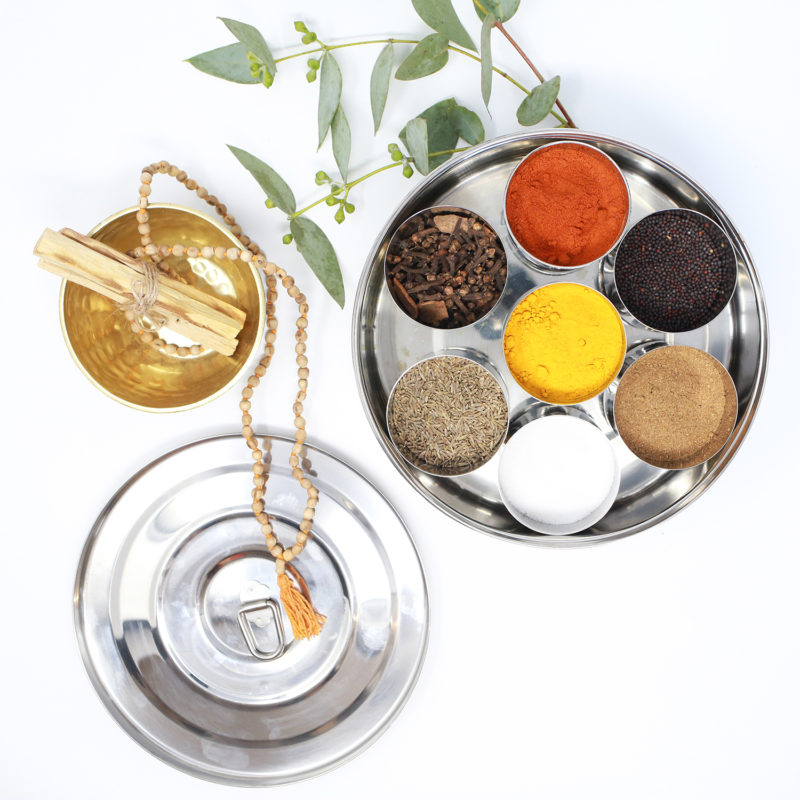
Say Hello To Vata, Pitta & Kapha (and Say Hello To Yourself)
Have you ever wondered what actually accounts for differences in people? Why some people are hyperactive and fast-moving and others steady and reserved? Or, why some people can eat a five-course meal with ease and others can barely finish a salad without feeling digestive discomfort? Genetics offers some insight, but what about the characteristics and idiosyncrasies that make every person unique?
Ayurveda, a form of constitutional medicine originating in India over 5,000 years ago, answers these questions with three energetic archetypes, three distinct forces that together, govern all physical and mental processes. Known as doshas, these principles are universal and yet they exist in varying ratios within each of us. In fact, according to Ayurveda it’s this ratio—the specific combination of these doshas—that influences our mind-body type, shaping our traits and tendencies.
Taking it one step further, not only do the doshas account for the differences in our nature (and ability to digest that salad), they are dynamic, responsive to the foods we eat, our emotions experiences, the climate and other sensory inputs that feed our mind and body.
Ayurveda then, is the process of understanding the archetype that most dominants our constitution and the ways in which the things we do, eat, think about, etc. supports this energy or disturbs it, creating an imbalance in mind-body.
Before going further, let’s meet these governing forces…
The Doshas: Ayurveda’s Three Energetic Archetypes
The three Ayurvedic archetypes, or doshas, are derived from the five elements of nature — ether, air, fire, earth, water — and their related properties. These three energies are known as Vata, Pitta and Kapha.
Vata
This dosha derives from the elements of space and air and translates as “that which moves things.” It is the energy of movement and the force governing all biological activity. Vata is often called the “King of the doshas,” since it governs the body’s greater life force and gives motion to Pitta and Kapha.
The qualities of Vata are those of ether and air: It is dry, rough, light, cold, subtle, and mobile.
Accordingly, Vata universally governs anything related to movement, such as breathing, talking, nerve impulses, movements in the muscles and tissues, circulation, assimilation of food, elimination, urination, and menstruation. Psychologically, Vata governs communication, creativity, flexibility, and quickness of thought.
If Vata is dominant in your body and moves out of balance, you experience excess “air” in your body. In a lot of cases, this is exactly how it feels: Bloating, gas, indigestion. It can also manifest as anxiety (fast movement of thoughts), dry skin, constipation, poor circulation and a feeling of ungroundedness.
Pitta
This dosha derives from the elements of fire and water and translates as “that which cooks things.” It is the energy of digestion and metabolism in the body. While Pitta is most closely related to the element of fire, it is the liquid nature of these substances that accounts for the element of water in pitta’s make-up.
The qualities of Pitta are predominantly those of fire: It is oily, sharp, hot, light, moving, liquid, and acidic.
Accordingly, it’s Pitta that provides the body with heat and energy through the breakdown of complex food molecules. It governs all processes related to conversion/transformation throughout the mind and body. Psychologically, Pitta governs joy, courage, willpower, anger, jealousy, and mental perception. It also provides the radiant light of the intellect.
If Pitta is dominant in your body and moves out of balance, you experience excess heat and inflammation in the body. It can show up as rashes, excess sweating, heartburn, diarrhea, acid reflux, ulcers, impatience and irritability.
Kapha
This dosha derives from the elements of earth and water and translates as “that which sticks.” It is the energy of building and lubrication that provides the body with physical form, structure, and the smooth functioning of all its parts. Kapha can be thought of as the essential cement, glue, and lubrication of the body in one.
The qualities of Kapha are those of water and earth: It is moist, cold, heavy, dull, soft, sticky, and static.
Accordingly, Kapha moistens food, gives bulk to our tissues, lubricates joints, stores energy, and relates to cool bodily fluids such as water, mucous and lymph. Psychologically, Kapha governs love, patience, forgiveness, greed, attachment and mental inertia. With its earthly makeup, Kapha grounds Vata and Pitta and helps offset imbalances related to these doshas.
If Kapha is dominant in your body and moves out of balance, you can experience mucus build up that translates into allergies, asthma and respiratory problems, water retention, lethargy and heaviness (especially after meals).
So, how do you know which is dominant?
First of all, if you relate to all three, that’s normal. These are universal forces that as you just read, are collectively responsible for all mind-body functions. Additionally, you may relate strongly to one right now but feel as though you related to another at a different time in your life. That’s normal too since the amount of each within us is always changing. This is why figuring out which energetic archetypes most influences you and your life can be tricky. All that said, this quick breakdown may just help you recognize yourself!
You are likely Vata dominant if you’re….
- Physically slender, tall, long-limbed or have a delicate body frame
- Experience cold hands and feet; discomfort in cold climates; dry skin and hair
- Have a variable appetite and delicate digestion
- Like to think creatively, often operating outside of conventional “norms”
- Tendency to dislike routine and repetition
- Respond to stress with anxiety, fear or worry
You are likely Pitta dominant if you’re….
- Physically medium size, strong, well-built
- Experience overheating; have reddish skin and sunburns easily
- Have a strong appetite and good digestion; irritable when hungry
- Like to be orderly and are overall focused and determined
- Enjoy challenges and competition but can become critical of self or others
- Respond to stress with irritability, anger, frustration
You are likely Kapha dominant if you’re….
- Physically strong and with a sturdy or broad build
- Dislike cold, damp climates and often has clammy hands/feet
- Frequently experience congestion, sinus headaches, respiratory problems
- Strive to maintain harmony, peace and is a point of stability for others
- Tends to hold onto things both material and emotional
- Responds to stress with worry, lethargy, withdrawal
So these are Ayurveda’s archetypes! In reality, an Ayurvedic understanding of constitutions is much subtler than what’s outlined here. Each person has elements of all three doshas, so reducing a person to a single dosha is an oversimplification. You can also have a Vata-Pitta constitution in which two doshas are balanced fairly evenly, and a few people are even tridoshic, meaning they’ve got a more or less even balance of all three. People may also manifest temporary imbalances that do not reflect their underlying nature. For example, people of any constitution who undergo the movement, disruption, and stimulation of travel may find Vata out of balance. Therefore, even a thoughtful consideration of your dosha cannot take the place of a dosha quiz combined with an in-depth evaluation by a qualified Ayurvedic practitioner. You can establish a good indication of the primary doshas in your constitution, but an evaluation allows for deeper understanding and application. Still if you see yourself in this overview, here are a few tips to balance:
To Balance Vata
- Wear layers and keep a scarf on hand
- Choose foods that are warm, cooked, nourishing and easy to digest
- Maintain at least a few regular habits — try to eat and sleep at the same time every night
- Favor exercise that is grounding and slow like meditative yoga, Tai chi, walking and swimming
To Balance Pitta
- Keep cool by avoiding overexposure to sun and too much spice food
- Choose fresh vegetables and fruits that are watery, cooling and sweet
- Include play and time in nature in your routine
- Cultivate a soothing meditation practice focused on loving-kindness and generosity
To Balance Kapha
- Start the day off with movement to wake up mind and body
- Choose foods that are light, warm, and spicy
- Seek new activities and experiences that promote stimulation and a change of perspective
- Involve the senses with invigorating essential oils and massage


